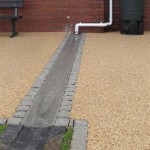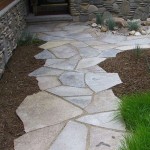Creating The Perfect Flagstone Patio Flooring
Flagstone patios offer a timeless and aesthetically pleasing outdoor living space. The natural variations in color, texture, and shape of flagstone create a unique and inviting environment. Designing and installing a flagstone patio requires careful planning and execution to ensure both durability and visual appeal. This article will detail the key steps involved in creating a flagstone patio that will last for years to come.
Planning and Design Considerations
Before commencing any physical work, a thorough planning phase is crucial. This encompasses assessing the site, determining the desired size and shape of the patio, selecting the appropriate flagstone material, and planning for necessary drainage.
The initial step is a comprehensive site assessment. This entails evaluating the existing soil conditions, identifying any potential obstacles such as tree roots or underground utilities, and determining the overall slope of the area. Soil testing may be necessary to determine its load-bearing capacity and drainage characteristics. Poor soil conditions may necessitate soil amendments or stabilization measures.
The size and shape of the patio should be carefully considered in relation to the surrounding landscape and intended use. Consider the amount of space needed for furniture, entertaining, and pedestrian traffic. A scaled drawing of the proposed patio area helps visualize the final product and identify any potential design flaws before construction begins. The drawing should incorporate the dimensions of the patio, the location of any existing structures or landscape features, and the proposed layout of the flagstones.
Selecting the right type of flagstone is paramount. Flagstone is available in a variety of materials, including sandstone, slate, limestone, and quartzite, each with its unique properties and aesthetic characteristics. Sandstone is known for its durability and warm colors, while slate offers a more contemporary look with its smooth surface and darker hues. Limestone is a relatively soft stone that is prone to scratching and weathering, making it more suitable for less trafficked areas. Quartzite is a very hard and durable stone with a shimmering appearance.
The choice of flagstone depends on several factors, including the desired aesthetic, budget, and climate. Consider the local climate and the potential for freeze-thaw cycles, as some types of flagstone are more susceptible to damage from these conditions. Also, consider the slip resistance of the stone, especially if the patio will be exposed to water. Samples of different types of flagstone should be obtained and evaluated to ensure that the chosen material meets the desired criteria.
Proper drainage is essential to prevent water from pooling on the patio surface and damaging the underlying base. The patio should be sloped slightly away from any buildings or structures to allow water to runoff. In areas with heavy rainfall, a drainage system may be necessary to collect and divert water away from the patio. This may include installing French drains or surface drains. A well-designed drainage system will prevent water damage and extend the life of the patio.
Preparation and Installation
Once the planning phase is complete, the next step is to prepare the site and install the flagstone. This involves excavating the area, creating a stable base, and laying the flagstones in a pattern that is both aesthetically pleasing and structurally sound.
The site should be excavated to a depth of at least 6 inches, depending on the type of base material used. The excavated area should be wider than the planned patio to allow for edging and drainage. Any topsoil or organic matter should be removed, as it can decompose and cause the base to settle unevenly. Ensure that any underground utilities are clearly marked and avoided during excavation.
A stable base is crucial for preventing the flagstone from shifting or settling over time. A base typically consists of a layer of compacted gravel or crushed stone. The thickness of the base should be at least 4 inches, but may need to be thicker in areas with poor soil conditions or heavy traffic. The base material should be compacted using a plate compactor to ensure that it is dense and stable. Compaction is essential for creating a solid foundation that will support the weight of the flagstone and prevent it from shifting.
After the base is compacted, a layer of sand or stone dust should be spread over the surface to create a smooth and level bedding layer for the flagstone. This layer should be about 1 inch thick and should be compacted lightly. The sand or stone dust will fill in any small gaps in the base and provide a uniform surface for the flagstone to rest on.
Laying flagstone is a skill that requires both patience and attention to detail. Start by placing the largest flagstones first and then fill in the gaps with smaller stones. The flagstones should be positioned so that they fit together tightly and create a visually appealing pattern. A rubber mallet can be used to gently tap the flagstones into place and ensure that they are level. Leave a small gap between the flagstones, typically ranging from 1/2 inch to 1 inch, to allow for expansion and contraction due to temperature changes.
Various patterns can be used for laying flagstone, including random patterns, running bond patterns, and circular patterns. A random pattern is the most common and involves laying the flagstones in a seemingly arbitrary arrangement. A running bond pattern involves laying the flagstones in rows with staggered joints. A circular pattern involves laying the flagstones in a circular or spiral arrangement. The choice of pattern depends on the desired aesthetic and the shape of the patio.
Jointing and Finishing
The final step in creating a flagstone patio is to fill the joints between the stones and finish the surface. This step is crucial for preventing weeds from growing, stabilizing the flagstones, and enhancing the overall appearance of the patio.
The joints between the flagstones can be filled with a variety of materials, including polymeric sand, mortar, or gravel. Polymeric sand is a mixture of sand and polymers that hardens when wet, creating a durable and weed-resistant joint. Mortar is a mixture of cement, sand, and water that is used to create a strong and permanent joint. Gravel is a natural and permeable material that allows water to drain through the joints. The choice of jointing material depends on the desired aesthetic, climate, and budget.
When using polymeric sand, the joints should be thoroughly cleaned and dried before applying the sand. The sand should be poured into the joints and then swept into place using a broom. After the joints are filled, the sand should be lightly compacted and then wetted down with a hose. The water will activate the polymers and cause the sand to harden. It is important to follow the manufacturer's instructions carefully when using polymeric sand.
When using mortar, the joints should be cleaned and dampened before applying the mortar. The mortar should be mixed according to the manufacturer's instructions and then applied to the joints using a trowel. The mortar should be smoothed and shaped to create a consistent and visually appealing joint. Any excess mortar should be wiped away with a damp sponge. Mortar joints require regular maintenance and may need to be re-pointed periodically to prevent cracking and crumbling.
When using gravel, the joints should be filled with gravel that is appropriately sized for the width of the joints. The gravel should be compacted lightly to prevent it from shifting. Gravel joints are permeable and allow water to drain through them, which can help prevent water from pooling on the patio surface. Gravel joints require occasional maintenance to remove weeds and debris.
After the joints are filled, the flagstone surface can be sealed to protect it from staining and weathering. A variety of sealers are available, including penetrating sealers and topical sealers. Penetrating sealers penetrate the surface of the stone and create a water-repellent barrier. Topical sealers create a protective coating on the surface of the stone. The choice of sealer depends on the type of flagstone and the desired level of protection. Always test the sealer in an inconspicuous area before applying it to the entire patio.
To maintain the flagstone patio, regular cleaning is recommended. The patio can be cleaned with a hose and a mild detergent. Avoid using harsh chemicals or abrasive cleaners, as they can damage the stone. Weeds should be removed regularly to prevent them from growing in the joints. The patio should be inspected periodically for any cracks or damage and repaired as needed. With proper care and maintenance, a flagstone patio can provide years of enjoyment.

How To Build A Flagstone Patio In One Day Merrypad

How To Lay Flagstone Installation Guide Landscaping Network

How Much Do Flagstone Patios Cost In 2024 Forbes Home

Choosing The Best Flooring For Your Patio Circle D Construction

How To Build A Paver Patio Young House Love

How To Install A Flagstone And Gravel Patio Or Pathway

How To Build A Paver Patio Young House Love

The New Brick Patio Designs For Your Flooring Cute 25 Best Ideas About Paver On Design Backyard

Explore Stunning Patio Ideas With Natural Stone Sui

Low Maintenance Ground Covers To Go With Your Pavers
Related Posts








